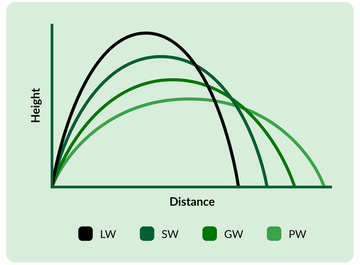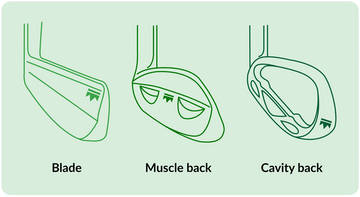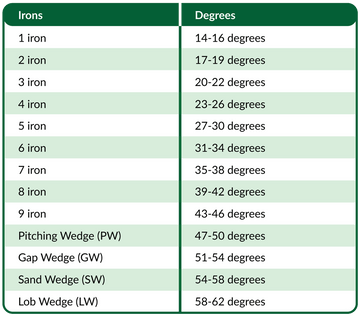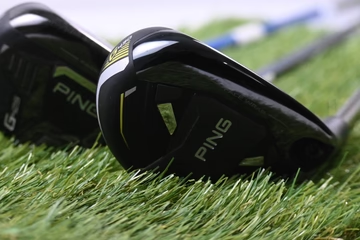One of the questions we hear a lot (seriously, a LOT) at golfclubs4cash is “How do I choose the right golf iron for me?”. That’s closely followed by questions like, “Which golf brand makes the best irons?”, “How do I choose the best second-hand golf iron deals?”, and “Which golf irons do the golf pros use the most?”.


The Ace Series: Your complete, in-depth guide to irons
So, it’s safe to say that you lot are obsessed with both individual golf irons and iron sets (and to be fair, so are we). The first place we always point our customers to is our handy buyers’ guide to golf irons. You’ll find a wealth of information there including how to choose the perfect golf iron, what sort of factors you need to take into consideration, and useful information like how to tell when it’s time to upgrade your golf iron.
While the buyers’ guide is a great place to start, it’s also a good idea to swot up on everything you need to know about irons - e.g., how they’re made, what the history of irons is and what technical considerations go into making a golf iron. So, in our Ace Series, we take each club individually and drill right down into everything you could ever need to know about them. Check out our Ace Series for drivers, too, and you’ll see what we mean.
In this month’s edition of the Ace Series, we shine the spotlight firmly on golf irons. So, let’s get stuck in.
The absolute basics of a golf iron
Golf irons have a crucial role to play in improving your game, chiefly by delivering precision and consistency over distance. Golfers who are shopping for a new golf iron are interested in things like whether it’s going to be forgiving, whether it’s user-friendly, and if it’ll help to mitigate their unavoidable mishits (we all have them!).

While a driver is all about gaining maximum distance thanks to its oversized club head, irons are more about precision (although, distance is still a factor). If you’re hitting a tee shot and you need to get your ball as far as possible, then you’ll use a driver. But if accuracy is important along with direction and distance, then you could opt to tee off using an iron instead.
Iron sets are made up of around 5-10 different irons, and each has a specific job to do in terms of distance and accuracy. The other main thing to understand about irons is that most golfers don’t make their set up of individual irons as a rule, and that’s because every iron set is configured. (For all you newbie golfers out there who might be tempted to build a set of irons from different brands etc., - don’t! Invest in a used configured iron set and thank us later). For example, a configured Titleist iron set might be made up of six clubs from a 5-iron through to a pitching wedge (PW), while another set might be a nine-piece set (e.g. 3,4,5,6,7,8,9, PW, SW).


Pitching Wedge (PW)
Sand Wedge (SW)
Gap Wedge (GW) - sometimes called a Utility Wedge (UW) - just to confuse you
Lob Wedge (LW)
Looking for a new iron set? Start your search below.


Srixon ZX7 MK II Irons 2023 / 5-PW / Stiff Flex N.S.PRO Modus3 Tour 120 Shafts


Taylormade P790 2023 Irons / 5-9i / Regular Flex KBS Tour Shafts


Titleist T100 2023 Irons / 6-PW / Regular Flex AMT Black R300 Shafts


Taylormade P770 2024 Irons / 4-PW / Stiff Flex Dynamic Gold Mid 115 S300 Shafts


Titleist T150 Irons / 5-PW+48° / Stiff Flex SteelFiber i80cw Shafts


Taylormade P790 2023 Irons / 4-PW+GW / Stiff Flex Dynamic Gold 105 S300 Shafts


Taylormade P770 2024 Irons / 5-PW+GW / Stiff Flex Aerotech SteelFiber i80 Shafts


Left Hand Taylormade P770 2023 Irons / 5-PW / Regular Flex UST Recoil ES 780
The complete history of golf irons - from then to now
Before iron was used as a material to make golf clubs, what we now know as ‘irons’ used to be made from wood, and they were often crafted in a very rudimentary way. Unlike the numbering system that is used today, each iron had a name. A higher-lofted iron (similar to a 9-iron) was called a Niblick, and a modern-day 5-iron was called a Mashie.

Later in the golf club’s evolution, it was decided that each club would be numbered, but the logic as to each iron’s specific number wasn’t properly considered. It feels slightly counterintuitive for an iron with a lower number, e.g. a 3-iron, to be longer than a 4-iron, which is longer than a 5-iron… etc. This tends to confuse newer players, because you’d expect it to be the other way around (e.g. the higher the number, the longer the iron). In physical terms, the longer the golf club, the further the clubhead is away from the fulcrum (you), and therefore the more difficult it is to control.
There’s no industry standard or rule when it comes to the length of an iron, which brands often use to their advantage and they’re always checking out the lengths of their competitors’ irons. Not all comparable irons are equal in length, for example, TaylorMade might have a set of irons with a 7-iron that is longer than a PING 7-iron. That’s another reason why the 3 and 4-irons are becoming less common - because in theory, the 5-iron is a modern-day equivalent version of the 3-iron.
The numbering system hasn’t changed, but a few brands have taken the step of removing the number and instead specifying the loft of the club (possibly to be seen as progressive). This way is more intuitive, even if it bucks the trend of heritage and habit. Most brands have dipped in and out of this approach as a trial. A change to the numbering system has been more prominent in wedges - PW, SW, GW, LW - those names are now commonly being replaced by a specified loft.
How to use an iron
Your golf iron technique won’t be too different to any other club that you use, but there are a few exceptions. Your iron is generally used for your first shot on a par-3 (e.g. it’s expected that it would take the average professional or scratch golfer 3 shots to complete the hole). A par 3 will generally be quite short - one shot (usually with the iron, depending on the length from the tee to the green) onto the green, plus two putts.
At this point, as things get pretty technical, it’s worth saying that we’re assuming you have an average level of golf knowledge. If we’re losing you and you need to go back to basics, then don’t panic - you can check out our other blogs to find out more about golfing terminology, the beginners’ guide to golf, and the rules of golf.
Anyway… the other time you might use an iron would be your second shot on a par-4 or par-5 where there’s a premium on distance and direction. You’d typically use your driver for the first shot to gain maximum distance (albeit with a wider margin for error), before using your iron to become gradually more accurate as you play the shot.
Similarly, on a par-4 or par-5 where there is water, you might use an iron from the tee to maximise your chances of hitting the ball straight. There are no hard and fast rules when it comes to which club to use where, but as a general rule of thumb, if you think “iron” for precision, “driver” for distance, you won’t go far wrong.
Looking for an individual iron? Find your perfect club below.


Titleist T100 2021 #4 Iron / 24 Degree / Stiff Flex Titleist Steel Shaft


Callaway Apex Pro 16 #8 Iron / Stiff Flex Project X Shaft


Titleist 718 AP1 #4 Iron / 21 Degree / Regular Flex N.S.Pro Modus3 Tour 105


Nike Vapor Speed #4 Iron / 21 Degree / Regular Flex Dynalite 105 Shaft


Titleist AP1 2008 #4 Iron / 22 Degree / Regular Flex Aldila VS Proto-T 75 Shaft


Ladies Taylormade Burner Superlaunch #9 Iron / Ladies Flex Reax 50


Ladies Taylormade Burner Superlaunch #8 Iron / Ladies Flex Reax 50


Ladies Taylormade Burner Superlaunch #7 Iron / Ladies Flex Reax 50
Which golf irons are best for beginner golfers?
A novice golfer is going to be keen to use irons which offer maximum forgiveness and plenty of tolerance for the mistakes they are bound to make along the way. Forgiveness is typically achieved by using a hollowed-out area at the back of the club head (called cavity-backed irons). Beyond this, weighting is strategically placed around the perimeter of the cavity. This increases the club head’s moment of inertia (MOI), which in turn makes the iron’s head more resistant to twisting, keeping the ball on a straighter path.
This forgiveness, often referred to as the ‘sweet spot’, means that cavity-backed irons are particularly popular among recreational and beginner golfers. Beginners often choose cast irons (see below) as opposed to forged irons, because they are the more affordable choice.
Which golf irons are best for intermediate and advanced golfers?

We’re tackling intermediate and advanced golfers in one hit here, given that they are both looking for the same things when it comes to choosing a golf iron (although advanced players gravitate towards smaller club heads, with less-pronounced cavity back designs, or a bladed muscle back design.
Intermediate and advanced golfers often favour this bladed muscle back design. The blade of a muscle back lacks perimeter weighting and looks like an old-fashioned razor blade. This offers minimal forgiveness, but gives the advanced golfer the flexibility to manipulate the ball flight, whether they are shaping shots from right to left (draw) or left to right (fade). This alters the trajectory of the shot to achieve higher or lower flights. So, if you’re an accomplished golfer who can afford to make a compromise on forgiveness, the bladed muscle back iron is for you.
Golf iron casting
The club head of an iron is either cast or forged, and this is one of the most significant considerations when you’re looking to find a golf iron that will suit you. First, we’ll look at casting.
Casting is the more cost-effective option for irons, because manufacturers can replicate shapes quickly and consistently by pouring liquid steel compound into wax moulds where the metal cools and hardens. The downside of casting is that harder compounds like nickel can reduce feedback and therefore responsiveness. Cast irons are the cheaper option, and a popular choice with beginners who prioritise cost over precision.
Golf iron forging
By contrast, forged golf irons use a different technique (think of the way that a blacksmith shapes or ‘forges’ a horseshoe - they’ll start with a solid bullet of steel and hammer it into shape). It’s a far more labour-intensive way of making a golf iron club head, but it results in a softer compound which includes carbon - and sometimes even titanium for the most expensive clubs. This softer compound means better responsiveness, which advanced golfers love.b head of an iron is either cast or forged, and this is one of the most significant considerations when you’re looking to find a golf iron that will suit you. First, we’ll look at casting.
Because the forged irons require a more complex process and more expensive materials, they are the more expensive option.
These days, a compromise is available. Certain brands, for example Titleist, are making golf irons with a cast body (so that weight can be moved where it needs to go for forgiveness), but adding a forged face for better feel and control.
Golf iron adjustability in more detail
Adjustability in golf irons isn’t much of a consideration. That’s because it’s harder to demonstrate verifiable differences in performance with a small club head, compared to a 460cc driver head (for example) that has plenty of different location options when it comes to weight distribution. So, weight isn't something that manufacturers worry about or factor into their iron head design,
Length of irons

Length is the first variable to consider when you’re learning about the difference between golf irons. The shortest club (e.g. the 9-iron or the PW) means that the head is closer to you (as the fulcrum), and therefore easier to control, helping you hit the ball straighter.
The other variable is loft. The 3-iron has less loft than a 4-iron, etc. With loft, the more loft you have on a clubface, the more backspin you can impart on the golf ball, and the more the ball spins backwards and the straighter it flies. So the most lofted club like a PW or a 9-iron will fly straighter than a 3-iron or 4-iron.
When you couple both loft and length, the shorter the iron and the more loft that it has, the more precise you can be with it. The longer the club and the less loft it has, the further the ball is likely to fly, but the tradeoff is how easy it is to hit consistently.
Iron shaft material and flex
When it comes to iron shaft material, you have two choices: steel or graphite.
Graphite was first introduced around 20-30 years ago, and it was common for it to be perceived to be inconsistent in the way in which it bent (the harder you swing a golf club, the more it bends). So, professionals back in the day stayed away from graphite shafts because they couldn’t rely on it bending appropriately. These days, graphite is now as consistent as steel thanks to better manufacturing tolerances and the way that irons are designed.
The main difference between graphite and steel now is weight. Graphite shafts can be made to weigh less than steel, so they are popular with slower swingers (for example ladies and seniors). The other benefit of graphite is that it’s very soft and responsive, taking the vibrations out of mishits. This lack of vibrations makes graphite particularly popular with golfers with arthritis.
Steel is a heavier shaft material, and it can be manufactured so that it is very stiff. A stiff flex won’t bend as much as graphite, and as better golfers don’t like a lot of flex they all tend to use steel shafts.
How much should I spend on an iron?
Irons range considerably in price from rock-bottom prices (think £20 and upwards for second-hand individual golf irons) right through to hundreds of pounds. Much depends on your budget, but when you buy second-hand you’ll be able to bag a bargain for a fraction of the price of new. Check out our individual golf iron sale, and also our golf iron set sale to grab a great deal today.
Which are the leading iron brands?

The top four leading golf brands - Callaway, PING, Titleist and TaylorMade all supply a range of iron sets that are enduringly popular with golfers everywhere, and often spotted at the major golf tournaments worldwide.
Other than the usual suspects, there’s one other brand that’s notable for its irons, and that’s Mizuno - the oldest and largest Japanese golf brand has a healthy market share of forged irons. That’s because Japanese brands like Mizuno have a rich heritage in the forging process and methodology.
Today, most premium forging houses for golf club manufacturing are based in Japan for that very reason, and many of the leading brands outsource the manufacturing of their forged irons. This is the reason why better golfers will gravitate towards forged Mizuno irons - so now you know!
More resources
We hope you’ve found our golf iron edition of the Ace Series useful. If so, check out our other iron-focused blogs, like:
Browse our entire range of top-quality used iron sets and individual irons, and get in touch if you have any questions at all!









